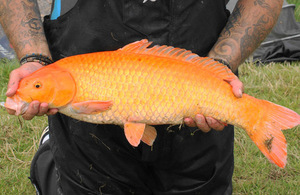Warnings over dangers of releasing ornamental fish into the wild
Advice from the Ornamental Aquatic Trade Association Ltd and the Environment Agency

Ornamental fish such as Koi Carp should not be released into the wild
People looking to release unwanted pet fish into local ponds and lakes are urged to find alternatives as this can have a devastating impact on native species and ecosystems.
Ornamental fish such as goldfish and koi carp can carry disease and parasites which can have a devastating effect on coarse fish populations and have major commercial impacts on fisheries.
They should be kept in garden ponds and not transferred into the wild. As well as the risk of disease, goldfish and carp can also interbreed with crucian carp, a threatened species, leaving ponds with hybrid populations.
Keith Davenport, Chief Executive of the Ornamental Aquatic Trade Association Ltd said:
If you choose to own a pet this is a commitment to keep that animal for its lifetime.
However, if for any reason you cannot keep your pet for the whole of its life then you should make suitable arrangements to rehome it, making sure of course the new owner has full accurate details of the care it requires. Pet shops, pet societies or rehoming groups may be able to assist.
Any rehoming must only be done with whoever accepts the fish being fully aware that in saving one fish they may jeopardise the biosecurity of those they already have.
Jerome Masters, fisheries technical officer at the Environment Agency said:
Fish movements are regulated by the Environment Agency. Releasing fish into the wild or moving them between or into fisheries without getting consent from the Environment Agency is an offence under the Keeping and Introduction of Fish Regulations 2015.
Many pet fish will be unsuited for life in the wild and so their release could also be an offence under the Animal Welfare Act 2006.
Angling clubs wishing to move or introduce any fish are required to register their fisheries with the Centre for Environment, Aquaculture and Fisheries Science (Cefas) and obtain a site permit from the Environment Agency. The permit details the species that can be kept in the fishery.
A permit is also needed if the fishery contains non-native fish. Introductions or movements may require health checks to be carried out on a sample of fish before they can be consented.
These controls are in place to manage the risks posed by spreading non-native fish species and fish parasites, and of inappropriate stocking.